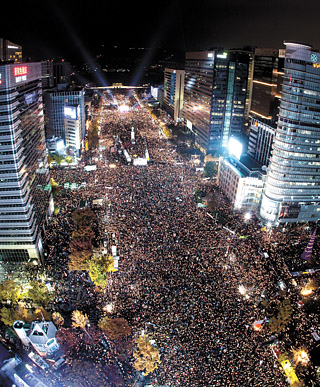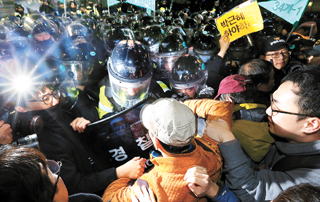Anti-Park rally draws record crowd

Gwanghwamun Square is filled with protestors calling for President Park Geun-hye’s resignation Saturday. Up to one million people took to the streets, according to organizers, the biggest street rally since June 1987, when people poured into the streets to demand a direct presidential election. People marched beyond the statue of King Sejong on Gwanghwamun Square and reached an intersection near Gyeongbokgung Station, the first time ever for demonstrators to reach so near to the presidential residence. Two additional rallies are planned for the next two Saturdays to demand President Park’s resignation. [NEWSIS]
As in previous candlelight vigils held on the past two Saturdays, people from all walks of life poured into the streets holding candles and banners that read “Park must resign!”
Organizers said the number of protesters in Seoul’s Gwanghwamun Square reached one million and ranged from parents with toddlers to senior adults with their sons and daughters. Police estimated the number of protestors to be 260,000.
Saturday’s rally was Korea’s biggest since June 26, 1987, when an estimated 1.4 million people protested nationwide against the authoritarian Chun Doo Hwan regime, demanding democracy. That massive rally helped force the Chun government to agree to direct presidential elections, and Korea has been an electoral democracy since.
It also surpassed the 2008 protest against U.S. beef imports, when an estimated 700,000 people took to the streets to protest the Lee Myung-bak administration.
The rally stretched from Gwanghwamun Gate to Seoul Station, or 2.6 kilometers (1.6 miles). Approximately 100,000 people from outside Seoul came to take part.
Protestors were calling for the president to resign for giving unprecedented power over state affairs to one of her friends, Choi Soon-sil, even though she had no official position or expertise.
Many among the crowd said it was their first time protesting.
“I came out for the first time in my life out of frustration with President Park,” said Jung Seong-hee, 58. “I never expected to see a president who so blatantly violated the Constitution. I want her out of office immediately. She does not deserve the power she now exercises.”
“Who gave the power to President Park?” asked one high school student from a stage, “that she then gave to Choi Soon-sil?”
“We did!” the crowd cried.
Another protestor named Sarah Park, a 27-old company worker, told the Korea JoongAng Daily that she decided to join the rally because she wanted to show President Park and the political establishment that people care.
“I think it is important to make them feel pressure from our joint engagement to bring about change,” she said, “whether it be Park’s resignation or in other forms. I wanted to contribute to that joint effort to make it happen.”
A number of political heavyweights joined the protest, including former Minjoo Party Chairman Moon Jae-in and Seoul Mayor Park Won-soon, both of whom are expected to run for president next year.
Leaders of all the opposition parties, as well as some lawmakers from the Saenuri Party, were seen at the protest.
“President Park must answer to the people who are out on the streets today,” said Moon, who competed against Park in the 2012 presidential campaign. “If she does not, an orderly exit for her will be impossible and state affairs will head toward collapse.”

Police who are stationed to block off areas near the Gyeongbokgung Station, central Seoul, push back against protestors in the midst of the nation’s largest rally, which involved up to one million people. [WOO SANG-JO]
The Saturday protest was the third of its kind since the Choi scandal erupted.
Protestors were able to march in front of Gwanghwamun Gate near Gyeongbokgung Subway Station, which is less than one kilometer from the Blue House. It was the first time a demonstration at the venue came so close to the presidential residence. People were allowed to march to that point thanks to the Seoul Administrative Court’s decision earlier in the day to accept a request by the rally organizer to halt the police ban on the protest in such proximity to the Blue House.
In its decision to lift the ban on the protest at the intersection near the station, the court pointed out that the rally was not led by one particular interest group but was voluntarily organized by a variety of people.
“By not resorting to the strict interpretation of legal restraints on the rally,” said the court, “but instead allowing people to organize without restraint, we uphold the democratic principles of our country.”
The protest ran until around 3 a.m. Sunday, when police dissolved the remaining crowd facing a police line located on the road that directly leads to the presidential office. Minor scuffles between protestors and police occurred during the standoff but no major injuries were reported.
The massive rally has emboldened the opposition’s resolve in their demand that Park withdraw from all domestic and foreign affairs and let the National Assembly pick a new prime minister.
Some are calling on Park to lay out a timetable for her resignation so that a presidential election can take place earlier than Dec. 20 of next year. Under the Constitution, a by-presidential election must take place within 60 days of a presidential resignation.
Critics of the Park administration have demanded her immediate resignation so that a new election can be held within 60 days to elect her successor.
Another possible scenario is for lawmakers to impeach the president. To do that, a two-thirds parliamentary vote is required. The decision will then be deliberated on by the Constitutional Court.
Given the composition of the current National Assembly, in which three opposition parties command the loyalties of 165 lawmakers, the opposition bloc needs 35 votes from the ruling Saenuri Party.
Even if an impeachment is approved through the Assembly, it is possible for the Constitutional Court to strike it down, as it did in the 2004 impeachment against former President Roh Moo-hyun.
“The president should be on a path to impeachment in the name of the people,” said Kim Moo-sung, the former Saenuri chairman, during a party emergency meeting on Sunday. This marks a turnaround from his previous position, in which he disapproved of impeaching the president.
In response to the massive call for Park’s resignation, the Blue House said Sunday Park was “deeply aware of the gravity of the situation,” but did not elaborate on her next move.
BY KANG JIN-KYU [kang.jinkyu@joongang.co.kr]










with the Korea JoongAng Daily
To write comments, please log in to one of the accounts.
Standards Board Policy (0/250자)